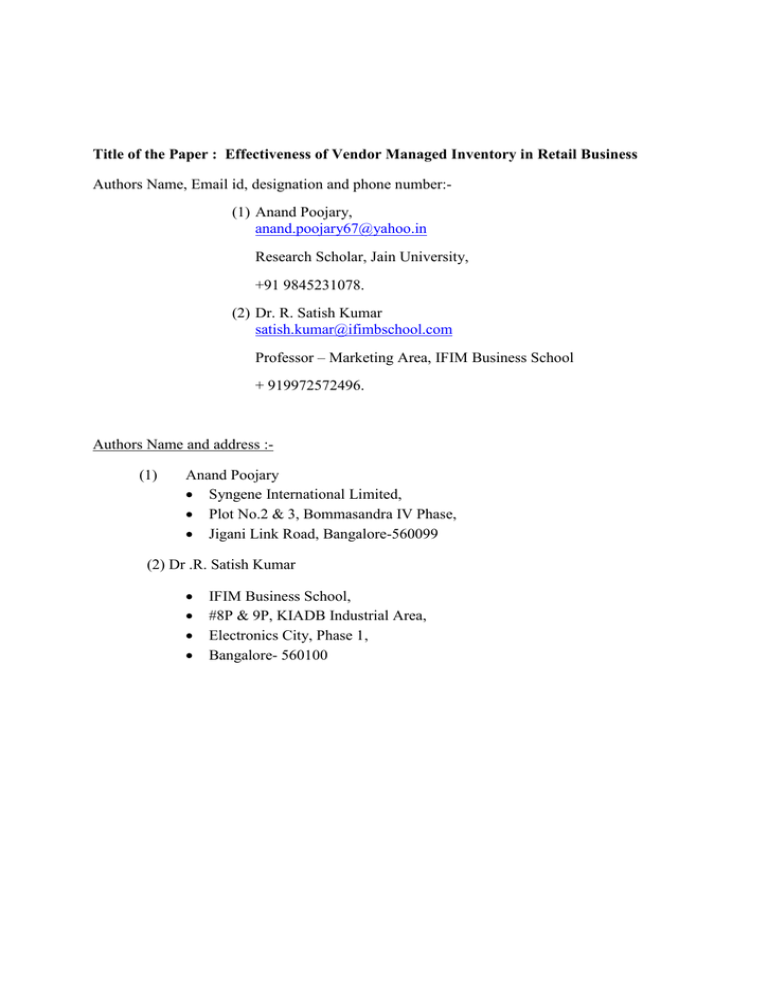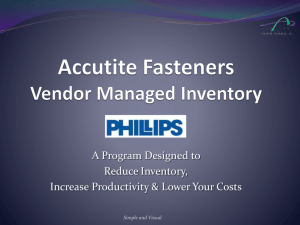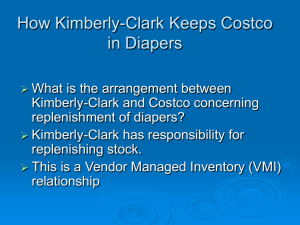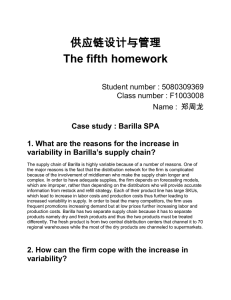Effectiveness of Vendor Managed Inventory in Retail business Abstract
advertisement

Title of the Paper : Effectiveness of Vendor Managed Inventory in Retail Business Authors Name, Email id, designation and phone number:(1) Anand Poojary, anand.poojary67@yahoo.in Research Scholar, Jain University, +91 9845231078. (2) Dr. R. Satish Kumar satish.kumar@ifimbschool.com Professor – Marketing Area, IFIM Business School + 919972572496. Authors Name and address :(1) Anand Poojary Syngene International Limited, Plot No.2 & 3, Bommasandra IV Phase, Jigani Link Road, Bangalore-560099 (2) Dr .R. Satish Kumar IFIM Business School, #8P & 9P, KIADB Industrial Area, Electronics City, Phase 1, Bangalore- 560100 Effectiveness of Vendor Managed Inventory in Retail business Abstract Vendor Managed Inventory (VMI) is gaining great momentum in retail business processes. It represents a powerful tool to remove cost from the supply chain. It is a streamlined approach to inventory and order fulfilment and it is a system in which a vendor continuously and automatically replenishes a trading partner’s inventory. Business exists to make profit in today’s world, these profits are realized in a number of ways including cost savings, improvement of working capital and reduction of risk. This paper sought to find out the contribution of adoption of Vendor Managed Inventories, as a strategy that business executives in the retail business chains could use to gain competitive advantage by leveraging on inventory supplier reliability, lower administrative costs, and strong buyer and supplier relationships to grow revenues and reduce risk. The findings suggest that VMI has been effective in retail business by improving stock management, cash flows and risk management. VMI seeks to accomplish a deeper integration and collaboration between the members of the supply chains in order to cope with the ever decreasing time window for product and service fulfilment and the requirements for the improvement of operational efficiency. Effectiveness of Vendor Managed Inventory in Retail business Anand Poojary(anand.poojary@syngeneintl.com) Research Scholar-Jain University Bangalore. (3) Dr. R. Satish Kumar (satish.kumar@ifimbschool.com) Professor – Marketing Area, IFIM Business School, Bangalore Abstract Vendor Managed Inventory (VMI) is gaining great momentum in retail business processes. It represents a powerful tool to remove cost from the supply chain. It is a streamlined approach to inventory and order fulfilment and it is a system in which a vendor continuously and automatically replenishes a trading partner’s inventory. Business exists to make profit, in today’s world, these profits are realized in a number of ways including cost savings, improvement of working capital and reduction of risk. This paper sought to find out the contribution of adoption of Vendor Managed Inventories, as a strategy that business executives in the retail business chains could use to gain competitive advantage by leveraging on inventory supplier reliability, lower administrative costs, and strong buyer and supplier relationships to grow revenues and reduce risk. The findings suggest that VMI has been effective in retail business by improving stock management, cash flows and risk management. VMI seeks to accomplish a deeper integration and collaboration between the members of the supply chains in order to cope with the ever decreasing time window for product and service fulfilment and the requirements for the improvement of operational efficiency. Introduction Vendor Managed Inventory (VMI) is receiving very good attention of late. In this era of tough competition retailers are implementing every possible supply chain optimization process that will reduce their costs, reduce inventory levels and maximise their profits. Efficient supply chain management requires the rapid and accurate transfer of information throughout a supply system. Vendor Managed Inventory (VMI) is designed to facilitate that transfer and to provide major cost saving benefits and increase profits to both suppliers and retailers customers (Vermond, 1999). Vendor Managed Inventory is a continuous replenishment program that uses the exchange of information between the retailer and the supplier to allow the supplier to manage and replenish inventory at the store or warehouse level. In this system, the retailer supplies the vendor with the information necessary to maintain just enough merchandise to meet customer demand. This system helps the supplier to better project and anticipate the amount of product it needs to produce or supply (Jorgensen, 1994). Vendor Managed Inventory (VMI) is one of the many initiatives that strive towards closer cooperation between the members of supply chains in the area of inventory and demand management (Daughtery, 1999). Vendor Managed Inventory is an inventory management process that falls under the push stock management processes. These are processes that are triggered by interpretation of an expected demand for stocks and supply is scheduled to meet this demand. Vendor Managed Inventory is inventory that is in the possession of the buyer, but is still owned by the supplier (Seldon, 2000). Payment of the inventory is made once it is sold. The capital investment on the stock comes from the supplier and the buyer provides space for it (Kumar & Kumar, 2003). The VMI initiative has the goal of accomplishing deeper integration and collaboration between the members of the supply chain in order to cope with the ever decreasing time windows for product and service fulfilment, and the requirements for the improvement of operational efficiency. Benefits mentioned as a result of adoption of VMI systems include lowered inventory levels, faster inventory turns, reduced ordering and administrative costs, better cash flow management, zero obsolescence, increased sales, and reduced out-of-stock costs among others. If a company’s Supply Chain and procurement department is successful in its balance between supplies and cost effectiveness, the company has better chances of surviving the current economic environment. This can be best illustrated in retail business that have to deal with multiple suppliers and large volumes of inventory. On this backdrop this study sought to evaluate the effectiveness of Vendor Managed Inventory systems in retail business (Haavik, 2000). Objectives of the VMI Improve Inventory Deficiencies Improving inventory deficiencies requires careful attention and monitoring of the VMI program by both Supplier and buyer to ensure the set goals are being met or are exceeding established product fill rates, product turns, and timing to reduce inventory levels and prevent “out-of-stock” situations. Increasing Product and Inventory Turns Essential to an ongoing partnership and successful VMI program is how well a product or inventory category turns are measured, calculated, and met. Inventory turns are calculated by dividing the average annual sales by the average inventory. Increasing Profits ANNUAL SALES / AVERAGE INVENTORY = TURNS Increase in profits is a win-win scenario for both the supplier and the buyer. Increased profits are obtainable only with consistent analysis of how well a product is selling and the proper inventory levels to help reduce costs. Concept of VMI Vendor Managed Inventory has been described as an inventory and supply chain management tool in which the supplier has taken the responsibility for making decisions on the timing and amounts of inventory replenishment. This system has also been called a continuous replenishment process, continual replenishment or automatic replenishment (Blatherwick, 1998). The advantages of using VMI to the downstream member, usually a large retailer, have well been documented (Cahon and Fisher, 1997). The main advantages of VMI were reduced costs, and increased customer service levels to one or both of the participating members (Waller, 1999). VMI’s advantages included improved customer service, reduced demand uncertainty, reduced inventory requirements and reduced cost (Fox, 1996). With the reduced stock-outs, suppliers not only saved, but they also received more information on the customer’s demand patterns that aided the supplier in planning better on their own inventories. The ability to plan better on inventories and deliveries are often cited as major advantages to the upstream member using VMI (Jain, 1994). An analytical model also developed to calculate inventory levels and delivery rates to minimize costs for small suppliers forced to use VMI by larger clients (Chaouch, 2001). One important finding of the study was that reducing variability in the amount and timing of the demand increased the benefits of lowered prices. In addition, VMI is an excellent tool when ordering the policies of the downstream supply chain members were less sophisticated and erratic, or when the distributor was selling to a large number of buyers with erratic buying patterns (Blatherwick, 1998). Determinants of Effective VMI Effectiveness as the extent to which actual performance compares with targeted performance (Armstrong, 1997). VMI effectiveness as the ability of the system to enhance competitive advantages through cost savings, relationships and information quality (Tarrulli, 2004). There are mainly seven theoretical factors or steps, impacting the success of VMI in retail market namely, industry structure, rivalry within the industry, buyer’s power, industry profitability, ability to develop long-term relationships, supply chain technology and adoption of Supply Chain Management best practices. In a VMI partnership, the supplier, usually the manufacturer but sometimes a reseller or distributor, makes the main inventory replenishment decisions for the consuming organisation. This means that the vendor monitors buyers inventory levels either physically or via electronic messaging and makes periodic re-supply decisions regarding order quantities, shipping and timing. Transactions that are customarily initiated by the buyer, such as purchase orders, are initiated by the supplier. Indeed the purchase order acknowledgement from the vendor may be the first indication that a transaction is taking place, an advance shipping notice informs the buyer of materials in transit. In this relationship, buyers relinquish control of key re-supply decisions and sometimes even transfer financial responsibility for the inventory to the supplier (Waller, Johnson and Davis, 1999). Research Methodology The study followed qualitative method, a comprehensive literature survey was conducted on inventory management functionalities, through conference papers, white papers and online sources to identify various work that has been covered in the VMI in enhancing the management of inventory. Findings and Discussion The study established that Vendor Managed Inventory scored high in aspects such as customer responsiveness, flexibility in the supply chain, levels of customer services, and management of stock outs. However, VMI was found to negatively affect material handling costs, and had zero effects on the inventory costs, transportation costs and administration costs of a retail store. The implications are that VMI as a system has more advantages than disadvantages. For example, the strength of VMI suggests that information sharing yields significant performance improvements for the supply chain (Zhang & Zhang, 2007). In addition, VMI effectiveness is dependent on internal and external operations integration. VMI benefited smaller organisations more than larger organisations (Kuk, 2004). This may be attributed to the level of seamless integration between internal and external operations and among partners in the supply chain. The study further established that majority of the users of VMI agreed that the system makes it easy to replenish, reduce incidences of stock out and rejection of deliveries, help supermarkets react to up and downs in demand, allow replenishment in friendly loads, enhance improved relationship between partners, increase accuracy in demand forecasts and overall improvement in customer service levels. However, still some of the users either agreed or were not sure whether VMI shortens the cycle times or more so, improves workers productivity. Overall, the verdict on implementation of VMI by the retail markets was a good idea and had more advantages than disadvantages. This supports as well makes the VMI a successful system (Tarulli, 2004). VMI enhances competitive advantage through cost savings, relationships and information quality. The implications are that VMI systems can be adopted by retail markets to gain competitive advantages. VMI - Inventory Flow The study established that VMI positively promotes inventory flow through reducing carrying costs, fewer product spoilage or damage, less wastage and reduces inventory holdings for a retail market. The study also found that VMI promotes faster inventory turns and through it, lower transportation costs have been realized by the retail markets. The implications are that by sharing information on inventory in time, providing information on demand, faster replenishments can be achieved, slow and fast moving goods can be identified and accurate demand forecasts can be made to match the inventory flow under VMI. This in turn reduces the buffer costs, carrying costs, stock out costs, and s high level customer service through product availability. VMI - Quality of ICT Systems The research also established that for an effective VMI, the retail market systems were compatible with those of the suppliers, and information was readily available, up to date and easy to use. Generally, the ICT systems among the majority of the respondents enhanced effective VMI systems. VMI has a strong and positive association to the quality of ICT and the relationship is statistically significant. Many studies have found out that VMI is information intensive and requires effective data base linkages among the supply chain partners to facilitate information flow. Investment in technical capability and technological know-how is essential to attract and maintain business with the right partner. The most promising relationships are where the two partners use a similar technology (Han, 1997). The implications are that ICT infrastructure is critical for the success of VMI. This is because ICT serves several purposes including the decision support framework, the conduit for real-time and timely information sharing in the supply chain, data storage, retrieval, and communication, and is also a transaction channel. The support of ICT on VMI is paramount. Information and Communication Technology (ICT) is a wide-ranging term that includes all technologies for the manipulation and communication of information. For instance, the internet is widely used for electronic mail (e-mail) and electronic commerce (e-commerce) including electronic invoicing, payments and receipt of materials process. Apart from that, more sophisticated solutions of ICT based technologies are emerging such as wireless communication, bar-coding and radio frequency identification (RFID) for tagging technologies. Thus, an appropriate implementation of ICT could facilitate more effective and productive VMI in retail business. VMI - Information Quality and Sharing The study found that that all the retail markets respondents agreed that information quality and sharing affect VMI effectiveness. They indicated that under VMI they make inventory data available to the suppliers, make usage or sales data available to suppliers, and offer reliable information to suppliers that are adequate, timely and complete. In addition, VMI was found to have a strong and positive association to the information quality and sharing (Davis, 2003). The positive influence of quality information support the information sharing yields significant performance improvements for the supply chain. The danger therefore lies in poor sharing of information, if not well shared between the retailer and supplier would have severe impact on the overall success of the VMI. The performance of VMI substantially decreases if the shared information is not up-to date (Kumar & Kumar, 2007). VMI - Relationship Quality The study found that the relationship quality is important for effective VMI in retail markets. For example, those utilizing VMI were satisfied with the supplier’s performance, and in general they were satisfied with their suppliers. In addition, they indicated that as a result of VMI, they could count on reliable suppliers and were convinced that such suppliers would live up to their deals and agreements of trust and reliability. The study also found that there was mutual trust among the majority of the respondents and their suppliers. However, VMI has a weak but positive association to relationship quality (Spekman, 1998). It is also observed that a good relationship between the buyer and the supplier improves supply chain performance (Hines, 2000). However, found out that implementing such a relationship is a challenge and requires trust, commitment, and resources and capabilities that are not always possible to allocate to a specific supply chain relationship. The implications are that quality relations may affect the success and performance of the VMI and across the supply chain. The quality of relations is affected by lack of mutual trust, dishonesty and lack of commitment among the partners in the VMI system. Challenges and Limitations of VMI The VMI approach has its own set of challenges and limitations: Interference with customer satisfactions as some goods on consignment are one-offs; high turnover with suppliers hence difficulties of implementation; and new suppliers may take time to develop credibility in their respective area of supply. While developing an analytical model to calculate inventory levels and delivery rates to minimize costs for small suppliers forced to use VMI by larger customers (Chaouch, 2001). Some companies continue to manufacture to stock without leveraging customer specific data effectively for production planning. In order to provide priority service to VMI partners, some vendors reserve inventory resulting in shortages to other customers. Insufficient level of system integration results in incomplete visibility. High expectations from retailers. Resistance from sales forces due to concerns of losing control, effecting sales based incentive programs. Lack of trust and scepticism from employees. Conclusion and Recommendations On implementation, the study concludes that VMI is a recent phenomenon in the retail business and steadfastly growing. The effectiveness of VMI in the retail business has been registered in improved stock management, cash flows and risk management. While VMI has been voted best by the retail business managers, it has its shortcomings associated with trust, turnover of suppliers and small scale suppliers who lack financial capacity to implement VMI concepts sustainably. Sometimes this interferes with customer satisfaction as some goods on VMI become one-offs due to the high turnover of suppliers because some new suppliers are yet to develop credibility in their respective area of supply. The study also concludes that VMI effectiveness as a system is affected by inventory flow, the quality of ICT and quality of information and sharing but is not affected by the quality of relationship. This indicates that relationship the among VMI partners is developed on the basis of implementing the system based on trust and reliability. However, the quality of ICT is most important to facilitate sharing of information among the VMI partners in the supply chain (Fisher, 1997). Finally, VMI as a system is suitable for large and medium size retail markets which have well established networks systems and the capability to effectively run the system. Very small partners or suppliers may not afford to have a large warehouse, or afford to lease a large warehouse for an effective VMI. Secondly, a retail market that is too small owing to its low buying power would lack capacity to support demand for goods that VMI warehousing requires (Damanpour, 1992). The study makes the following recommendations based on the findings and conclusions: first, the retail markets intending to partner in VMI should focus on developing strong ICT systems, strong warehousing facilities, either by lease or build and/or by engaging large suppliers to lease from third parties. This would hasten the implementation of VMI in retail markets. Also, the retail markets should enter into VMI agreements defining clearly the responsibilities and obligations of the parties involved. This would ensure a smooth flow of not only information sharing but also in the execution the VMI responsibilities as defined in the agreement to avoid mistrust and eventual fall out. In addition, VMI implementation can be phased with few established suppliers and with few non-shelf life goods. This would ensure reduced conflict with partners, and also allow employees to adjust to the new level of business. Lastly, the retail market should first implement an inventory policy that defines the optimal stock levels which is based on demand forecasts and actual usage or sales. This would ensure that VMI would minimize the impact of stock outs (Chopra & Meindl, 2007). Build strong partnerships with management commitment to effective communication, active sharing of information, commitments to problem solving and continued support. Conduct simulations and pilots before actual implementation. Organize training sessions before launching VMI program. Set reasonable targets for benefits of VMI. Establish agreements on service levels and process to handle exceptions. References (1) Blatherwick, A., 1998. Vendor-managed inventory: fashion fad or important supply chain strategy? Supply Chain Management, 3(1), pp.10-11. (2) Damanpour, F., 1992. Organisational size and innovation. Journal of Organisational Studies, 13(3) pp. 375-402. (3) Fejerskov, M., Hart, A., Kelly, S., & Meyn S., 2005. Early Supplier Involvement. Bang & Olufsen and Samsung. Copenhagen Business School, Denmark. (4) Fisher, M. L., 1997. What is the right supply chain for your product? Harvard Business Review, pp. 105-116. (5) Fox, M.L., 1996. Integrating vendor –managed inventory into supply chain decisionmaking. Conference Paper, APICS 39th International Conference. New York. (6) Haavik, S., Building a demand driven, Vendor managed supply chain, Healthcare Financial Management, 2000. (7) Jain, C.L., 1994. Ready or not, here comes vendor-managed inventory. Journal of Business Forecasting Methods and Systems, 13 (2), pp. 244. (8) Jorgensen, B., Vendors Manage Inventory, Electronic Buyer.s News, section: Distribution, Issue 920, Sept 1994 (9) Kuk, G., 2004. Effectiveness of vendor –managed inventory in the electronics industry: determinants and outcomes. Information and Management, 41 pp. 645-654. (10).Kumar, P., & Kumar, M., 2003. Vendor managed inventory in retail industry. White Paper, Tata Consultancy Services. (11).Seldon, B., Supply Chain Management: Vendor managed inventory- Fad or Future, Automotive Engineer, 2000. (12).Simchi-Levi, D., Zhao, Y., 2003. The value of information sharing in a two stage supply chain with production capacity constraints. Naval Research Logistics, 50(8) pp.888-916. (13).Spekman, R.E., Kamauf, J.W., Myhr, N., 1998. An empirical investigation into the supply chain management; a perspective on partnerships. Supply Chain Management, 3 (2) pp. 53-67. (14).Vermond, K., Vendor Managed Inventory: Changing relationships, moving inventory, Logistics and Supply Chain Journal, February 1999 (15).Waller, M., Johnson, E., Davis, T., 1999. Vendor-managed inventory in the retail supply chain. Journal of Business Logistics, 20 (1), pp.183-203. (16).Zhang, C., Zhang, C., 2007. Design and simulation of demand information sharing in a supply chain. Simulation Modeling Practice and Theory, 15(1), pp. 32-46.



